As one of the most powerful platforms in the world, Google is an essential tool for businesses wanting to get their products and services in front of the right people. Not only is it the world’s top-ranked search engine (by a mile), but it’s also a powerful ecommerce platform.
Some of the most valuable promotional activities for ecommerce owners are those that drive highly intentional actions from buyers. Google Shopping ads definitely fit into this category.
But what are Google Shopping ads and how do they work? Let’s dive into the platform to help you understand how to make the most of Google Shopping to drive sales and revenue.
What are Google shopping ads?
Google shopping ads are ads featured on the platform that drive customers to purchase through a relevant search. If you Google pretty much any product you can imagine, this is what you’ll see at the top of the search results page:
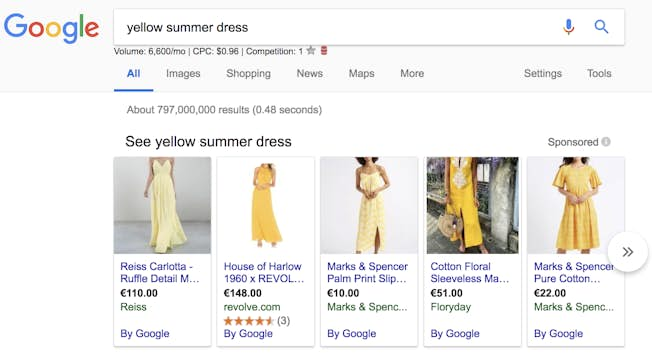
Another variation is on the right-hand side of the search results:

Unlike paid ads or display ads that typically lead to a wide range of landing pages and have various goals, Google Shopping ads — also known as Product Listing Ads or PLAs — rely on the feed that contains your products, including their price, name, image, reviews, and promotions.
Google uses the information from this feed to display a grid of products based on the search term. From there, a user can click through to the product and purchase from the seller’s website as usual.
If you’re trying to figure out how to create optimized Google ads, download our Google Ads Creator template.
Why Google Shopping Ads Work
Google Shopping ads have taken the paid media world by storm. Here are some statistics that showcase just how much:
- In Q4 2021, Google Shopping ad spending increased by 37 percent year over year, with clicks up 19 percent and CPCs up 15 percent - Tinuiti’s Google Ads Benchmark Report
- Google Shopping accounts for 65% percent for all Google Ads clicks and for 89 percent of non-branded Google search ad clicks of retailers - Merkle’s Digital Marketing Report
What is it about Google Shopping ads’ performance and profitability that makes them so popular?
There’s a simple answer: a combination of search intent and purchase intent.
Let’s look at several different levels of specificity and the way it relates to what the searcher had in mind when typing in their query:
Face mask - As an advertiser, you can’t quite narrow down what the user had in mind when searching for this. Is it a sleeping mask? A face mask? What skin type is in question? And what if it’s a pollution protection mask? It’s a vague search term. Google Shopping results have the same challenge:

Face mask for oily skin DIY - This term doesn’t show any purchase intent, but rather the need for information and DIY face mask recipes. As a result, no products are listed, and instead we see a featured snippet:

Face mask for oily skin - Now that DIY isn’t specified any longer, we see a carousel of products that all come from different sellers and brands. Google considers these masks good for oily skin types and aims to prompt the user to click through one of them to make a purchase. In this case, the user’s awareness of listed brands and sellers has the most impact on the purchase decision:
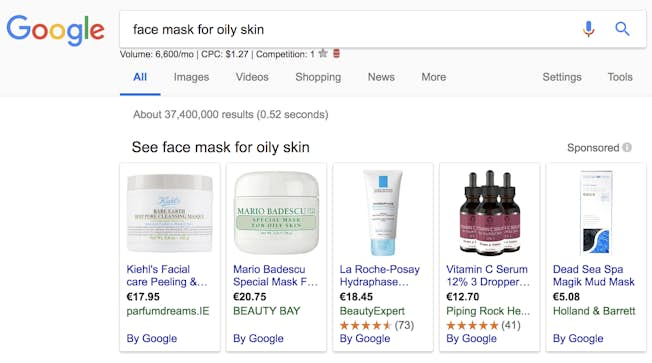
Glamglow Gravity mud - This is a search hyper-specific to a certain brand and its product. In this case, all the listed products are identical, but the sellers, prices, and reviews vary. In this case, it’s more likely that the price and shipping will influence the purchase decision the most:
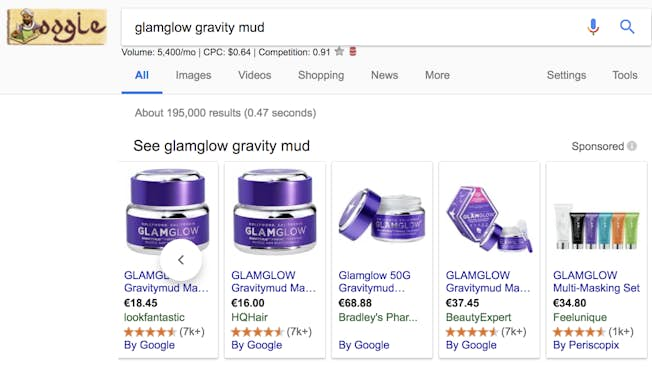
You can take almost any product category and come up with examples of lower and higher purchase intent queries. More specific terms typically mean a higher purchase intent and a better chance for products in Google Shopping to shine through and lead to a sale.
Some more examples:
- ‘Desk’ versus ‘white office desk free delivery’
- ‘Jeans’ versus ‘women’s high-waisted ripped skinny jeans’
- ‘Sneakers’ versus ‘white new balance sneakers womens’
“Facebook displays ads to users regardless of their purchase intent. You can get people who are interested in the topic, but who aren’t necessarily ready to purchase. Being interested in something and being ready, willing, and able to buy are two different things,” says Pete Boyle, a paid advertising and conversion rate optimization specialist. “On another hand, Google’s focus on different levels of intent means you can optimize for people who are ready to purchase,” he adds.
As you can see in the examples above, specificity in a search query can include product category, shipping, details, color, size, and much more—which brings us to what makes Google understand the products it lists.
How to Sell on Google Shopping
Google Shopping campaigns are powered by two systems: Google Merchant Center and Google Ads.
Unlike setting up a standard paid search strategy with campaigns, ad groups and ads, the nerve center of your Google Shopping campaigns will be in the Google Merchant Center.
Google Merchant Center is a tool that helps you upload your store and product data to Google to make it available for Shopping ads and other Google services.
As you’ve seen in the examples above, Shopping ads don’t display any copy or call to action — instead, they display the information a retailer has entered into their Merchant Center.
If you don’t already have one, you’ll need to set up a Merchants Center account.
How to set up your Google merchants account
The first thing you have to do to be able to run a Shopping campaign is to create a Merchant Center account. You can do this in a few easy steps:
- Go to the Merchant Center and click ‘Sign up’. If you’re not logged into any Google account, you will first be asked to do so (or to create one)
- Enter information about your business (country it’s based in, name and website)
- Accept Terms & Conditions
- Enter your website if you have one, then verify and claim it
Finishing the registration will take you to the Google Merchant Center dashboard, from where you can navigate to your business information, your products, and tax and shipping information.
Before you move on to setting up your product feed and your Shopping campaign, you need to become familiar with the Merchant Center guidelines and ensure your business is fully compliant.
Some of the main guidelines include:
- Promoting only products available for direct purchase (as opposed to affiliate and other products)
- Using the official language of the country you’re advertising your products to
- Enabling access to return and refund policies
- Meeting the product data specification, which Google outlines in detail
- For all guidelines and further directions, go to the Merchant Center guidelines
Next comes the most important step, and likely the most time-consuming one: setting up your product feed.
Create your product feed
You can do it in two ways: automatically (by using an integration) or manually.
The automatic setup means you leverage the platform your online store is hosted on to integrate your product information with your Merchant Center. You will typically have access to this if your store is on Shopify, BigCommerce, or Magento. Simply follow your platform’s instructions to make this happen.
Manual set-up requires you to enter all your product data through a file such as a spreadsheet.
In your Merchant Center, select Products > Feeds, then click the plus sign and follow instructions. You will soon reach this step that will provide you with a Google Merchant Center feed spreadsheet…
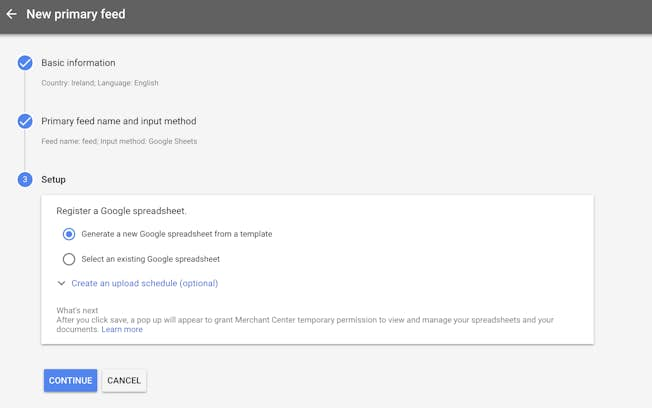
...which will include columns you need to fill out and instructions on how to do so:

The following is the most essential information that is part of a well-optimized product feed:
- ID: Your product’s unique identifier
- Title: Your product’s name
- Description: Your product’s description
- Link: Your product’s landing page
- Image link: The URL of your product’s main image
- Availability: Your product’s availability
- Price: Your product’s price
- Shipping cost: Your product’s delivery cost
- Tax (for the US): Your product’s sales tax rate in percent
- Condition: Your product’s condition (new, used, refurbished)
When it comes to certain items like clothing, you will also need to provide additional information such as gender, size, age group, color, and more.
Once your product feed is ready, it’s time to launch your Shopping campaign.
Choose your settings
The second part of the Shopping ads puzzle is the Google Ads platform. Think of it this way: the Merchant Center hosts your product feed, representing your shop in Google’s eyes. To amplify this shop, Google Ads lets you create a campaign and fine-tune it to your preferences.
Here are some key settings that make Shopping ads specific to the immediate context of the searcher:
- Choosing the country of sale
- Selecting locations that will display the ads (Google Search and Search Partners are selected by default)
- Bidding on your ads based on the price and competitiveness of what you’re selling
- Tracking conversions to be able to correctly attribute the impact of Shopping ads on sales
Both of these systems work through a regular Google account. For them to work together, the most important step is to link them from the Merchant Center interface.
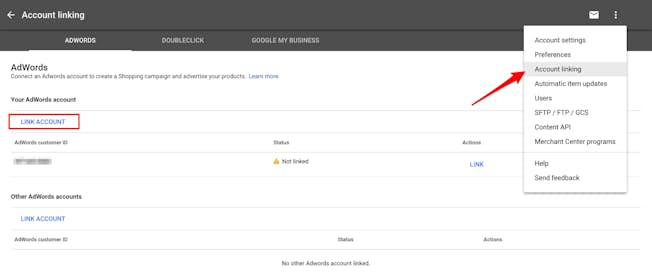
Create Your Shopping Campaign
You linked your Merchant Center and your Google Ads account earlier. From your Google Ads dashboard, select Campaigns, then click the plus sign. From here, you can select Sales > Shopping to start creating your Shopping campaign.
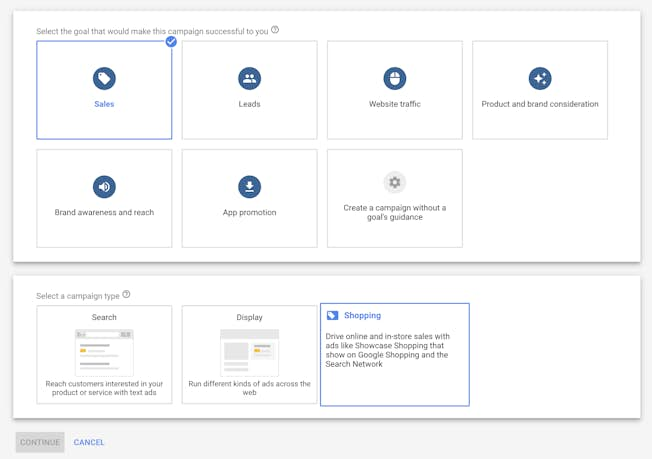
The settings you choose on the next page — bidding and budget — will largely depend on the cost of your products and the revenue they bring in. Here are some best practices, especially if you’re just starting:
- CPC bidding makes you pay by the click, and only if someone clicks. If 100 people see your ad but only three click, you pay for the three clicks. You can adjust this during your campaign to maximize your return on investment. (Read our blog ‘7 Ways to Boost Your Google Ads’ to get optimization tips.)
- Set your daily budget based on your monthly budget. If you’re a beginner, start with $10 to $50 as your daily budget and keep checking back to update your budget based on your campaign performance.
- Set the maximum bid at something you’re comfortable with in the beginning. As your campaign goes on, you will be able to edit this based on performance. Later on, you can work out your ideal maximum CPC with this guide.
Finally, set your locations correctly, and you’re good to go!
Google Shopping’s long-term success
To make sure your campaign is worth your investment and it keeps bringing you a positive return, here are some tips to follow.
- Only feature high-quality images -Make sure the product images you submit are high-resolution and that they match various options such as color and size. Test multiple variations if you have access to more than one high-quality image.
- Frequently consult your performance data - Over time, you will notice that some products sell better than others. You can add these best sellers to a specific ad group and raise bids to increase their exposure. Likewise, if a product is underperforming, you can move it to a new ad group with a lower bid.
- Make the most out of your reviews and ratings - Those star ratings you see in some examples are aggregated from multiple sites, including your own side, aggregator sites, and more. Entice your customers to review a product post-purchase using these five tactics.
- Your online store has the final say. No matter how enticing your Shopping ads are, if your store’s online interface doesn’t infuse trust, your visitors won’t want to buy. Take the time to make your product pages complete with clean headlines, thorough descriptions, high-quality images, reviews, and information on shipping and return policies.
If you follow these best practices, you will ensure that you show up for relevant search queries, but also provide the best experience for the buyer, from the moment they discover you to beyond the purchase.
How to Optimize Google Shopping Ads
It’s not enough to just move your shopping campaigns to Google, you need to ensure your company’s feeds are optimized for search to get the best results. So how do you do that? Here are 8 tips to help you:
- Use relevant keywords and phrases - this is particularly important for your ad titles and descriptions. As you saw from the face mask example above, specificity is key to reaching your target audience.
- Create high-quality images - People are drawn to visuals, so make sure that your images are of high-quality and relevant to the product displayed. You can add up to ten images for your ads so don’t limit yourself to just one.
- Use ad groups - Make sure to segment products or campaigns into groups that make sense and make it easy to measure performance and edit. For example accessories - jewelry - necklaces. This will aid in bidding too.
- A/B test ads - Don’t just rely on the first ad you create, try out different things like a product versus a lifestyle photo or use different copy such as an emphasis on quality or price to see what works. Here's an A/B testing toolkit and video to help you get started.
- Compare conversion rates - Track and measure conversion rates to see what’s working. This will help you to identify your winners and losers to boost your sales and decrease your CPA. You may be surprised by what category performs well.
- Use negative keywords - This will help you to exclude searches that are not relevant and unlikely to convert.
- Include an enticing offer - To help you stand out in the feed, think about including a discount or exclusive offer to drive clicks.
- Use bid adjustment - This can be done by location, device, or schedule so you can adjust your bids depending on customer behavior on an ongoing basis.
As you can see Google Shopping ads are a powerful tool to leverage search behavior. From a consumer perspective, it makes searching easy as they can quickly identify a product relevant to them.
Like any paid campaign, it’s important to track, A/B test and tweak to make the most of your ads. It’s never too late to get started and see how the platform can perform for your business.
Drive sales and revenue with Google Shopping ads
Improve the performance of your ads on Google and across digital channels with cutting-edge knowledge and skills. DMI’s Professional Diploma in Search Marketing developed with Neil Patel will introduce you to search marketing and teach you how to create great paid search campaigns, use analytics, apply SEO and much more. Book your place today to get started.
Updated 2022
Upgrade to Power Membership to continue
your access to thousands of articles, toolkits, podcasts, lessons and much much more.
Become a Power Member- Login
- View Courses
- - - -
- Courses
- Resources
- - - -
- My Account
- Change Password
- Logout





